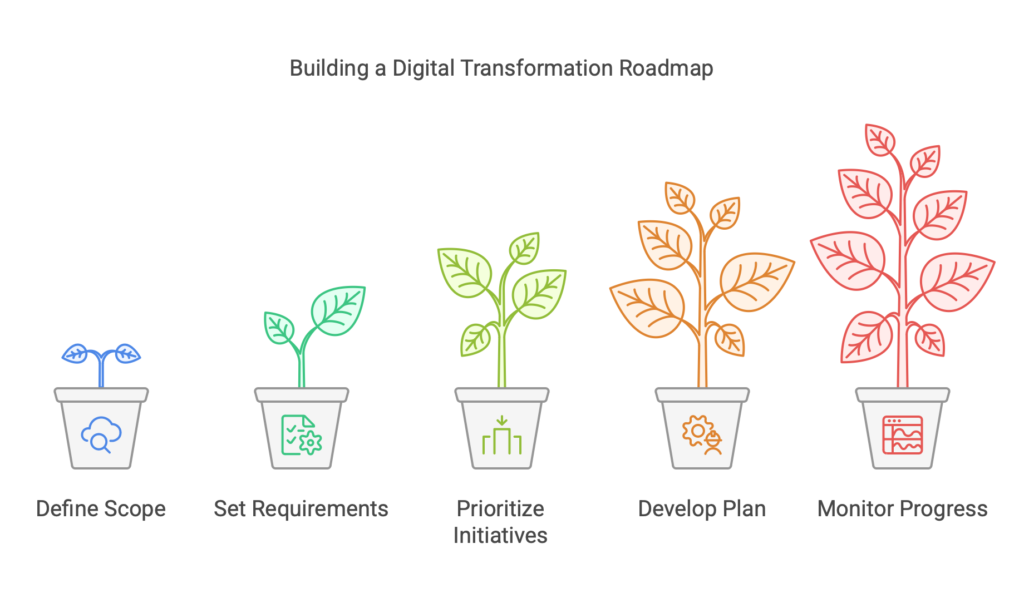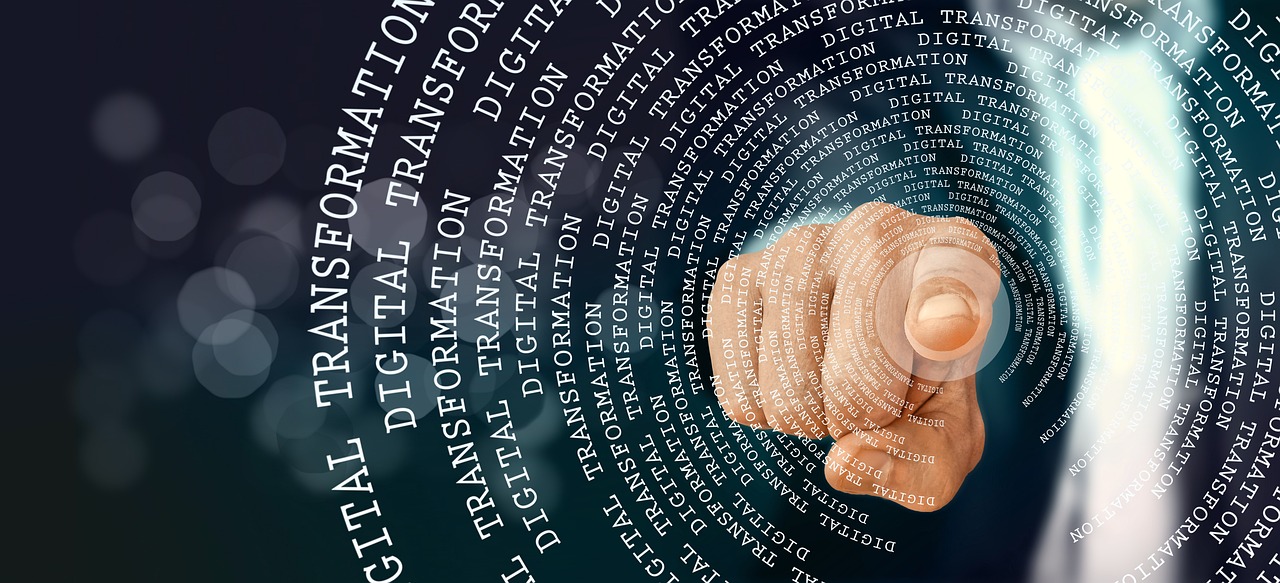In 2025, digital transformation (DX) is no longer an option—it’s a survival strategy. With global DX spending projected to reach $4 trillion by 2027, businesses that fail to adapt risk irrelevance. Consider this: AI-driven companies are growing revenues 3x faster than their peers, while those clinging to outdated processes face a 45% higher risk of bankruptcy.
But what exactly is digital transformation? At its core, DX is more than just adopting new technologies. It’s about rethinking how businesses operate, leveraging tools like AI, IoT, and cloud computing to create value at every level—from customer experience to operational efficiency.
This blog will explore:
- A clear definition of digital transformation and its importance.
- Key trends shaping industries in 2025.
- Real-world case studies of successful transformations.
- Actionable steps to kickstart your own DX journey.

What Is Digital Transformation?
Digital transformation is the strategic integration of advanced technologies across all aspects of a business to drive innovation, efficiency, and growth. However, it’s not just about technology—it’s about reshaping business models, processes, and culture.
At its core, digital transformation involves leveraging cutting-edge tools like AI, IoT, and cloud computing to create value at every level of an organization. This process goes beyond simply adopting new technologies; it requires a fundamental rethinking of how businesses operate and deliver value to customers.
Key aspects of digital transformation include:
Technology Integration:
Implementing tools such as AI, IoT, and blockchain to enable automation and data-driven decision-making. Advanced technologies are revolutionizing business operations across industries. For instance:
- Rolls-Royce leverages digital twin technology for aircraft engine maintenance. By creating virtual replicas of physical engines, they can monitor performance in real-time, predict failures, and optimize maintenance schedules. This approach has significantly improved operational efficiency and reduced downtime for airlines.
- Caterpillar employs IoT sensors to monitor equipment performance. The data collected is analyzed to optimize operations, reduce fuel consumption, and extend equipment lifespan. This has led to substantial cost savings and improved productivity for their customers.
- Walmart’s AI-powered inventory system reduced stockouts by 33%.
Process Reengineering:
Adopting agile methodologies to streamline operations and improve adaptability. Companies are reimagining their workflows to become more agile and efficient:
- Maersk, in partnership with IBM, created TradeLens, a blockchain-based platform that digitizes and tracks shipping documents. This innovation has streamlined the shipment process, reducing processing times from days to hours for international shipments like flowers from Kenya to the Netherlands.
- UPS revolutionized its delivery routes using predictive analytics. By analyzing traffic patterns and historical data, they discovered that right turns are more efficient than left turns. This simple change saved over 10 million gallons of fuel in a decade.
- Toyota, for instance, cut procurement time by 40% with AI-driven supply chain optimization.
Cultural Shift:
Fostering a digital-first mindset among employees and leadership.
- Unilever integrated AI-driven tools into its HR processes. They use platforms like HireVue for AI-assisted recruitment and Degreed for personalized employee learning paths. This approach has streamlined hiring, reduced bias, and improved the quality of talent acquisition and development.
- Atria Senior Living developed a custom CRM system and engagement apps to improve prospect management and family communication. This cultural shift towards digital solutions has enhanced operational efficiency and strengthened relationships with families and prospects.
- Adobe’s “Digital Fitness” program successfully trained 95% of its staff in AI basics within six months.
Data Utilization:
Leveraging predictive analytics to transform raw data into actionable insights.
- GE developed the Predix platform, an industrial IoT solution that monitors and manages assets in real-time. For example, they use it to monitor gas turbines, predicting failures before they occur and optimizing performance. This has significantly improved operational efficiency and reduced costs.
- Energy companies like Enersee use predictive analytics to forecast consumption patterns. By considering historical consumption, weather, and economic factors, they can anticipate major increases in energy demand, such as during drought seasons, and prepare accordingly.
- Rolls-Royce uses IoT sensors in jet engines to predict failures, generating significant revenue from maintenance contracts.
Customer Experience Enhancement:
Using digital tools to create personalized, seamless interactions across all touchpoints.
- JPMorgan Chase has streamlined its banking services with mobile apps and AI-driven financial tools, offering customers a more efficient and personalized banking experience.
- Disney utilizes data from wearable technology to provide personalized experiences for visitors. Guests are greeted by name, and their meal orders are pre-programmed, creating a magical experience.
Digital transformation is not a one-time project but an ongoing journey that requires commitment from all levels of an organization. It enables businesses to adapt to rapidly changing market conditions, meet evolving customer expectations, and stay competitive in an increasingly digital world. As we move further into the digital age, companies that successfully implement digital transformation strategies are positioned to thrive, while those that fail to adapt risk becoming obsolete. The goal is to create a more agile, efficient, and customer-centric organization that can quickly respond to market changes and capitalize on new opportunities.
Trends Shaping Digital Transformation in 2025
1. From Experimentation to Execution
Businesses are moving beyond pilot projects to embed digital tools into their core operations, prioritizing measurable outcomes over speculative experimentation. According to iGrafx, 2025 marks a turning point where AI transitions from a “shiny new toy” to an essential operational driver. Companies like Walmart exemplify this shift: their AI-powered inventory system reduced stockouts by 33% by analyzing real-time sales data and supplier lead times, translating to an estimated $1.2 billion annual revenue boost. Similarly, Pfizer now uses AI to accelerate drug discovery timelines by 70%, demonstrating how execution-focused strategies deliver tangible ROI.
The focus on execution is also driving consolidation in tech platforms. Organizations are replacing fragmented tools with integrated systems like Microsoft Azure IoT and PTC’s ThingWorx, which streamline workflows and improve interoperability. For instance, Colfax unified its IoT initiatives across global manufacturing units using ThingWorx and Azure, enabling centralized data sharing and predictive maintenance. This shift underscores a broader trend: businesses are prioritizing platforms that combine process mining, automation, and analytics to eliminate inefficiencies at scale.
2. Hyper-Personalization
Customers now demand seamless, individualized experiences, and companies are leveraging AI to predict needs before they arise. Amazon’s recommendation engine generates 35% of its revenue by analyzing browsing history and purchase patterns, while Netflix uses viewing habits to curate personalized watchlists, reducing churn by 25%.
However, hyper-personalization goes beyond algorithms. Nike has built a mini-ecosystem of apps (Nike App, SNKRS, Nike Training Club) that tailor experiences based on user activity. For example, the Nike App offers exclusive products to members who frequently purchase running gear, while SNKRS notifies sneaker enthusiasts of limited-edition drops. This strategy drove the SNKRS app’s revenue from $70 million to $700 million in five years, proving that personalization fosters loyalty. Similarly, Sephora uses AI tools like Skin IQ to analyze customers’ skin types and recommend products, reducing returns by 15% and boosting online engagement by 40%.
The key to success lies in combining real-time data with behavioral insights. Platforms like Salesforce’s Einstein AI and HubSpot now enable businesses to automate hyper-personalized campaigns across email, SMS, and web interfaces, ensuring every interaction feels uniquely tailored.
3. Cybersecurity as a Strategic Priority
As digital adoption accelerates, cyber threats grow more sophisticated. Splashtop’s 2025 cybersecurity report highlights two critical trends:
- AI-Powered Threat Detection: Tools like Microsoft Sentinel use machine learning to flag anomalies, such as unusual login attempts or data transfers, reducing breach detection times from days to minutes.
- Zero-Trust Architecture: Companies like JPMorgan Chase now enforce strict access controls, granting employees permissions only to systems essential for their roles. This model, combined with micro-segmentation, contains breaches and prevents lateral movement.
However, AI is a double-edged sword. Cybercriminals are deploying adaptive malware that learns from defensive responses, making traditional firewalls obsolete. For example, AI-generated phishing emails mimic writing styles of colleagues, achieving a 45% higher click-through rate than generic scams. To counter this, businesses are adopting Cybersecurity-as-a-Service (CaaS), partnering with providers like Splashtop for end-to-end encryption and multi-factor authentication.
4. Cloud and IoT Integration
The fusion of cloud computing and IoT is unlocking real-time operational insights. Colfax embedded IoT sensors into industrial equipment and connected them to Microsoft Azure’s cloud platform, enabling predictive maintenance that reduced downtime by 20%. Similarly, John Deere uses IoT-enabled tractors to collect soil data, which is processed in the cloud to optimize planting schedules, boosting crop yields by 12%.
In healthcare, Mayo Clinic integrates IoT wearables with cloud-based AI to monitor patients remotely. For instance, cardiac patients receive personalized alerts if their heart rate patterns deviate from baseline, enabling early interventions that cut ER visits by 30%.
This trend is fueled by platforms like AWS IoT Core and Google Cloud IoT, which offer scalable solutions for data aggregation and analysis. As latency drops to near-zero with 5G, industries from manufacturing to logistics are leveraging cloud-IoT synergy to drive efficiency.
5. Democratization of Digital Tools
[Bonus Trend]
While it’s not yet clear on the horizon, the democratization of technology is reshaping DX. Low-code platforms like Appian empower non-technical employees to build workflow automations, reducing IT backlogs. For example, Unilever trained marketing teams to create AI-driven customer segmentation tools, slashing campaign rollout times by 50%. This trend, highlighted by iGrafx, ensures that innovation isn’t confined to IT departments but becomes an organization-wide capability.
By 2025, businesses that master these trends will dominate their markets—those that lag risk obsolescence. The time for experimentation is over; execution, personalization, security, and integration define the new digital frontier.
Case Studies: Success Stories in Digital Transformation
Amazon: Reinventing Global Commerce Through Digital Dominance
Amazon’s evolution from an online bookstore to a $1.8 trillion tech titan is a masterclass in digital transformation. At its core is Amazon Web Services (AWS), which powers 34% of the global cloud market, enabling scalable infrastructure for millions of businesses.
- AI-Driven Personalization:
Amazon’s recommendation engine, powered by machine learning algorithms, analyzes browsing history, purchase patterns, and even mouse hover behavior to predict customer preferences. This system drives 35% of total sales, with personalized suggestions generating over $38 billion annually. - Operational Efficiency:
The deployment of Kiva robots in fulfillment centers reduced order processing time from 60 minutes to 15 minutes, cutting operational costs by 20%. Meanwhile, AI-powered demand forecasting slashed inventory errors by 50% in 2023. - Amazon Business:
Its B2B arm now serves 6 million corporate clients, leveraging AI to automate procurement workflows. For example, predictive restocking tools help hospitals like Cleveland Clinic maintain critical supply levels, reducing stockouts by 44%.
Amazon’s success lies in treating digital transformation as a continuous loop: test, scale, and iterate.
Mayo Clinic: Revolutionizing Healthcare with AI and Telemedicine
The Mayo Clinic’s digital-first strategy has redefined patient care, blending AI with human expertise to improve outcomes and reduce costs.
- AI Diagnostics:
Partnering with Tempus, Mayo Clinic developed an AI model that analyzes genetic data and medical imaging to personalize cancer treatments. This tool reduced diagnostic errors by 30% and accelerated treatment plans by six weeks. - Remote Patient Monitoring:
Using IoT-enabled wearables, Mayo tracks patients with chronic conditions like heart disease. Real-time alerts for abnormal vitals cut ER admissions by 25% and improved patient adherence by 40%. - Telehealth Expansion:
Post-pandemic, virtual consultations grew to 40% of total visits. Their platform integrates EHRs, AI triage, and prescription management, reducing wait times from 22 days to 48 hours for critical cases.
Mayo’s approach proves that healthcare transformation hinges on merging cutting-edge tech with compassionate care.
Maersk: Digitizing Global Trade with Blockchain
Maersk’s TradeLens platform, built with IBM, is a blockchain-powered solution that digitizes shipping documentation, addressing a $600 billion annual inefficiency in global trade.
- Streamlined Operations:
By replacing paper-based processes with smart contracts, Maersk reduced customs clearance times from 7 days to 1 hour for perishables like Kenyan roses. This saved shippers $1,200 per container in spoilage costs. - Transparency and Trust:
TradeLens provides end-to-end visibility for 20+ supply chain partners, including ports and customs agencies. During the 2023 Suez Canal blockage, Maersk rerouted 12,000 containers in real time, minimizing delays using predictive analytics. - Sustainability Impact:
Optimized routes reduced fuel consumption by 14%, cutting CO2 emissions by 4.8 million tons annually.
Maersk’s transformation underscores how digitizing legacy systems can turn logistical nightmares into competitive advantages.
How to Build Your Digital Transformation Roadmap

A structured roadmap is critical to avoid the 70% failure rate of DX initiatives. Here’s a step-by-step guide, refined with lessons from industry leaders:
1. Define the Scope
- Action: Conduct a digital maturity audit to identify gaps in customer experience, operations, or innovation.
- Tool: Use frameworks like McKinsey’s Three Horizons to balance short-term wins with long-term goals.
- Example: Unilever focused its scope on supply chain resilience post-COVID, deploying AI to predict raw material shortages.
2. Set Clear Requirements
- Action: Align stakeholders on must-have technologies (e.g., cloud, AI) and cultural shifts (e.g., agile teams).
- Tool: Create a RACI matrix to assign responsibilities (Responsible, Accountable, Consulted, Informed).
- Example: Walmart required suppliers to adopt RFID tagging, ensuring real-time inventory tracking.
3. Prioritize Initiatives
- Action: Rank projects by ROI and feasibility using the MoSCoW Method (Must-have, Should-have, Could-have, Won’t-have).
- Example: Domino’s prioritized AI-driven delivery routing over metaverse experiments, boosting on-time orders to 99%.
4. Develop a Detailed Plan
- Action: Break initiatives into sprints with milestones (e.g., pilot launch in 90 days).
- Tool: Use Agile methodologies and tools like Jira for iterative development.
- Example: Adobe’s shift to cloud subscriptions followed a phased rollout, reducing customer churn by 15%.
5. Monitor Progress
- Action: Track KPIs like Digital Adoption Rate (DAR) and Customer Effort Score (CES).
- Tool: Deploy dashboards like Tableau or Power BI for real-time insights.
- Example: Siemens uses IoT-generated data to refine predictive maintenance algorithms monthly, achieving 98% uptime.
The Bottom Line
Digital transformation isn’t a checkbox—it’s a mindset. Companies like Amazon, Mayo Clinic, and Maersk succeed by embedding innovation into their DNA. Start small, scale fast, and remember: the goal isn’t to adopt tech, but to redefine what’s possible.
The Time to Act Is Now
Digital transformation is not a one-time project—it’s an ongoing journey that requires commitment from leadership, employees, and stakeholders alike. Companies that embrace this evolution will thrive in the digital-first world of 2025 and beyond; those that don’t may struggle to survive.
Ready to start your transformation? Follow the roadmap outlined here to position your business for growth in the age of AI and automation.
You Might Also Like:
- What Is Digital Transformation In Simple Words?
- AI In Manufacturing: The Revolution Reshaping Factories NOW!
- AI In Leadership: The Shocking Truth About The Future Of Management
- Beyond The Hype: The Ultimate Digital Transformation Guide For 2025
- AI For Executives: A Strategic Guide To Leading In The Digital Age
